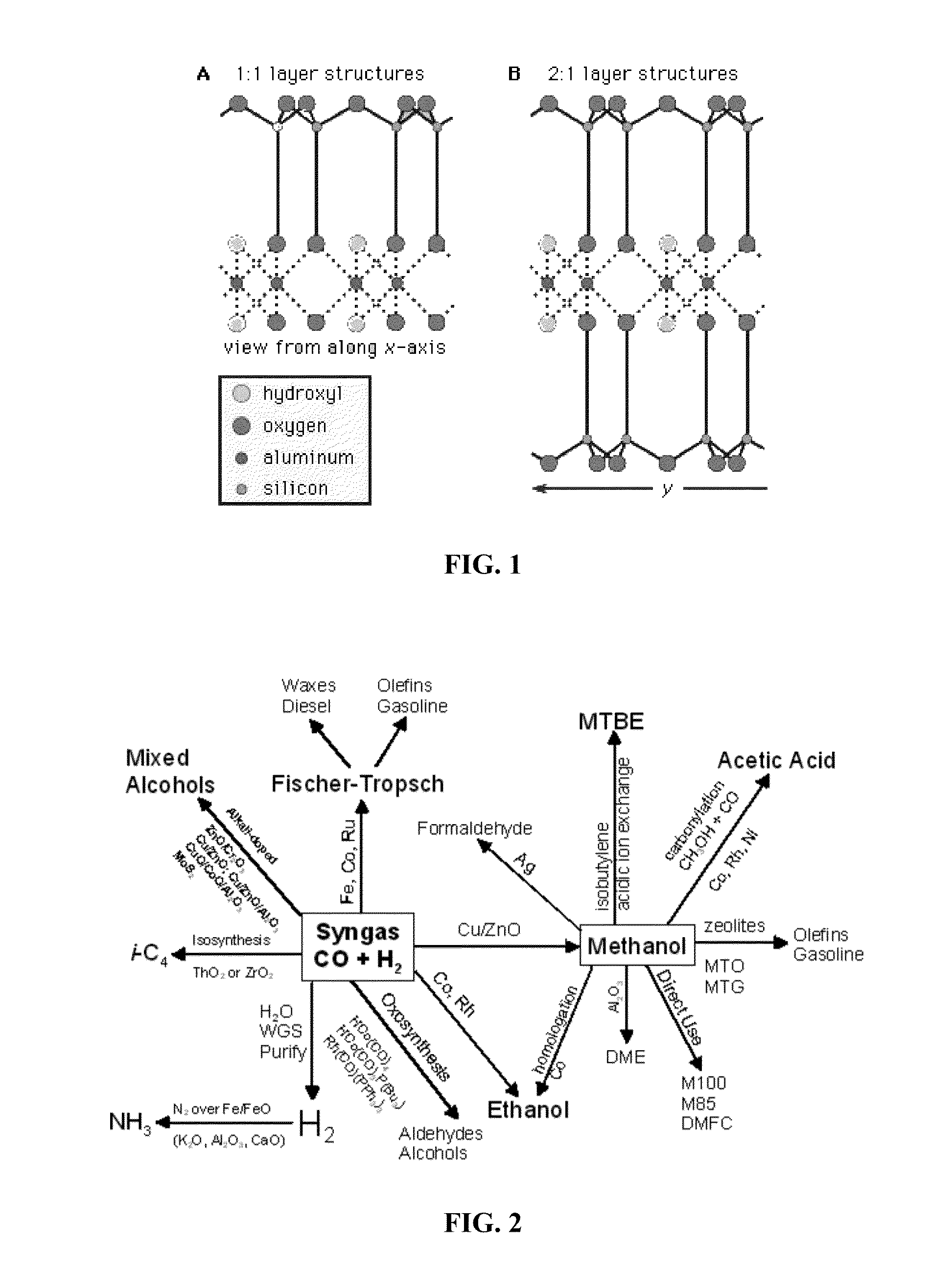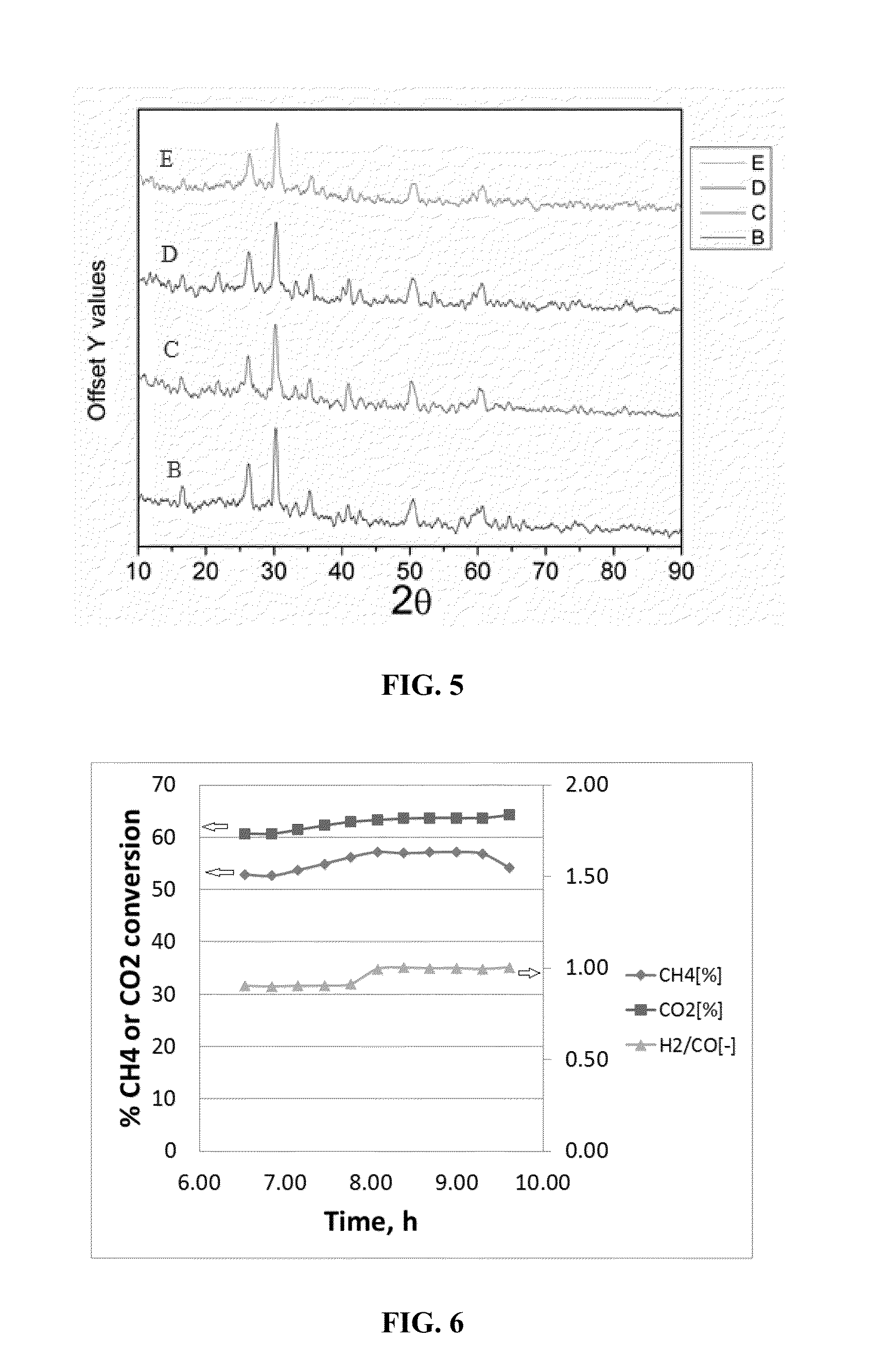Clay mineral supported catalysts
a technology of hydrocarbon gas reforming catalyst and support material, which is applied in the direction of hydrocarbon preparation, chemical industry, inorganic chemistry, etc., can solve the problems of reducing the active surface area of the catalytic material, increasing associated costs, and reducing efficiency production, so as to reduce coking and sintering and achieve superior durability.
- Summary
- Abstract
- Description
- Claims
- Application Information
AI Technical Summary
Benefits of technology
Problems solved by technology
Method used
Image
Examples
example 1
Synthesis of Clay Supported Catalysts
[0061]The following procedure was used to synthesize 10 wt % and 20 wt % of La2Ni0.11Zr1.89O7 pyrochlore catalysts grafted on Kaolin support: 0.8 g of La (NO3)3.6H2O, 0.4 g of ZrCl4, 0.02 g of NiCl2.6H2O was dissolved in 7.5 ml of de-ionized water to form a clear solution. 0.4 g of citric acid was added to the above solution. To this 5.1 g of purified kaolin powder (linear formula Al2Si2O5(OH)4) (obtained from Sigma-Aldrich®—K7375) was added and transferred the flask to the Rota evaporator. The material was allowed to mix in the Rota evaporator for 15 minutes and then evaporated the solvent under vacuum until the sample got dried completely. FIG. 3 is a transmission electron micrograph of neat Kaolin calcined at 1000° C. for 8 hours. FIG. 4 is a transmission electron micrograph of neat 10 wt % La2Ni0.11Zr1.89O7 / Kaolin catalyst calcined at 1000° C. for eight hours. For the 20 wt % catalyst, the quantities of metal precursors were doubled. It is co...
example 2
Use of Clay Supported Catalysts
[0065]CDRM reactions with 10 wt % CeO2 / 2 wt % Pt / Kaolin, 10 wt % La2Ni0.11Zr1.89O7 / Kaolin and 10 wt % La2Pt0.11Zr1.89O7 / Kaolin were performed at 800° C. and 1 bara, 800° C. and 1 bara, and 915° C. and 1 bara, respectively, for 20 hours. Prior to the reactions, each of the catalysts were first reduced in 10% H2 atmosphere at 900° C. for 4 h. Subsequently, the CDRM reactions were each initiated by changing the gas mixture to 10% CH4+10% CO2+80% N2. Both GC and Mass spectrometer were used to monitor gas composition. The 200-500 mesh size catalyst powder was used for testing, and the GHSV applied was 5000 h−1. Comparative CDRM reactions for each of the catalysts were also performed at the same pressure (1 bara) but at a temperature of 700° C. and coking and catalyst deactivation occurred at this temperature.
[0066]The CO / H2 ratio obtained from the reactions was about 1:1 (see FIGS. 6-8). Further, each of the catalysts were found to be stable without any dea...
example 3
Additional Catalysts
[0068]Two additional clay supported catalysts, 20% La6.5% Ni / Kaolin and 20% La2Rh0.11Zr1.85O7 / Kaolin, were tested for CO2 reforming of methane at 800° C. and 1 bara pressure. Both catalysts showed very good activity over a period of 180 and 100 hours respectively (see FIG. 9 (20% La6.5% Ni / Kaolin) and FIG. 10 (20% La2Rh0.11Zr1.85O7 / Kaolin)). Both catalysts were prepared according to the procedures used in Example 1.
[0069]The performance of both of these catalysts were tested in a highthroughput reactor system supplied by HTE, Germany. Reactors were of plug flow type and made up of steel SS316, with an inner ceramic liner. Ceramic liner with 5 mm in diameter and 55 cm in length was used to avoid coking due to methane cracking on steel surface. The gas between the inner steel surface and outer ceramic liner wall was sealed with the help of leak proof graphite ferrule, which ensures 100% feed gas passes through ceramic liner containing catalyst and inert material. C...
PUM
| Property | Measurement | Unit |
|---|---|---|
| particle size | aaaaa | aaaaa |
| temperatures | aaaaa | aaaaa |
| temperature | aaaaa | aaaaa |
Abstract
Description
Claims
Application Information
 Login to View More
Login to View More - R&D
- Intellectual Property
- Life Sciences
- Materials
- Tech Scout
- Unparalleled Data Quality
- Higher Quality Content
- 60% Fewer Hallucinations
Browse by: Latest US Patents, China's latest patents, Technical Efficacy Thesaurus, Application Domain, Technology Topic, Popular Technical Reports.
© 2025 PatSnap. All rights reserved.Legal|Privacy policy|Modern Slavery Act Transparency Statement|Sitemap|About US| Contact US: help@patsnap.com



